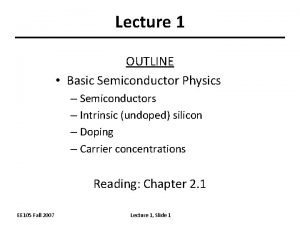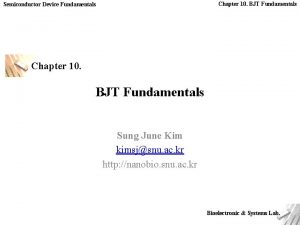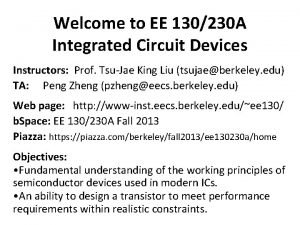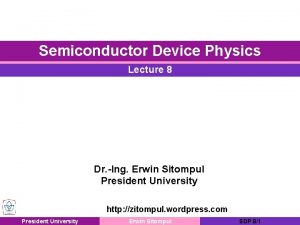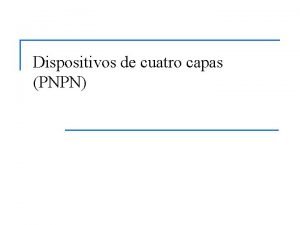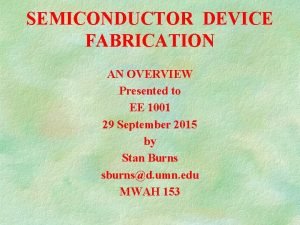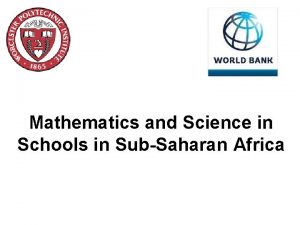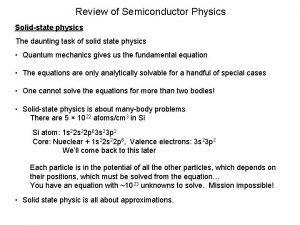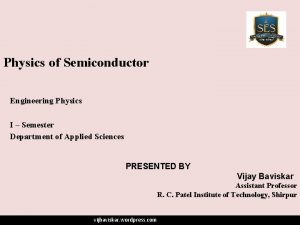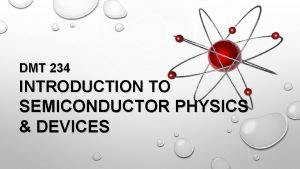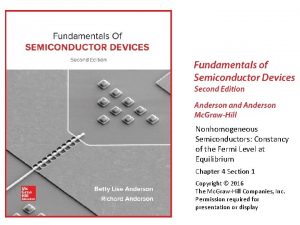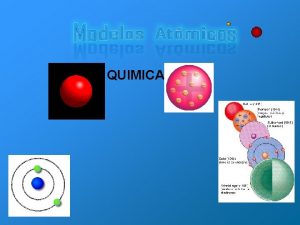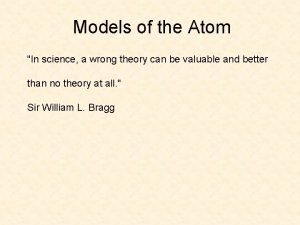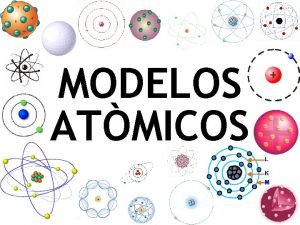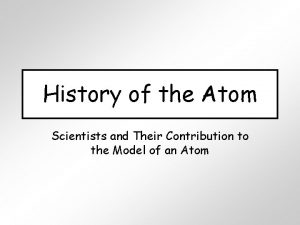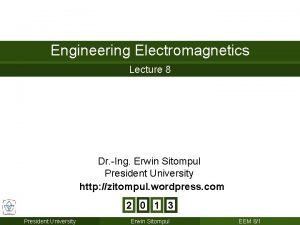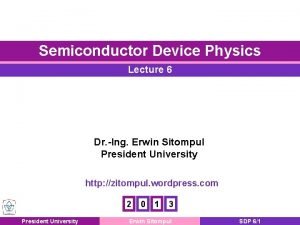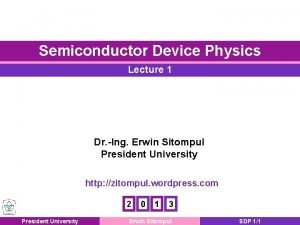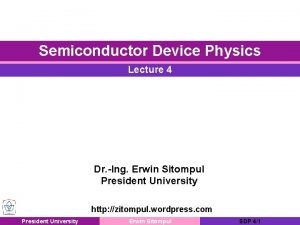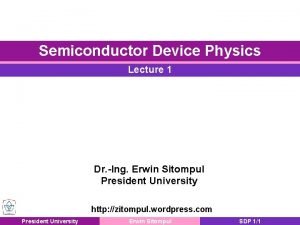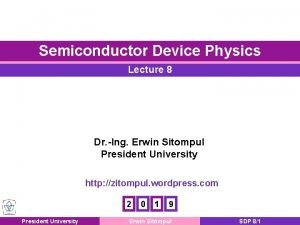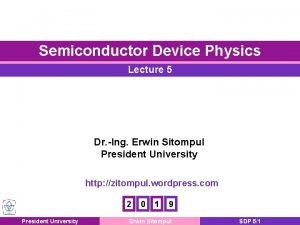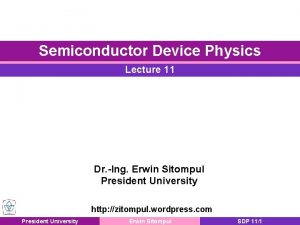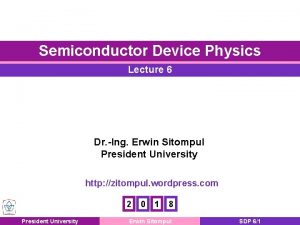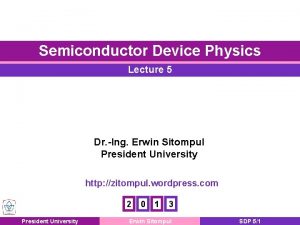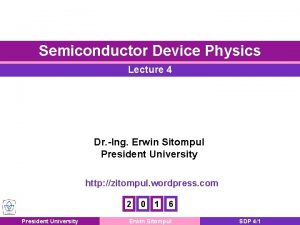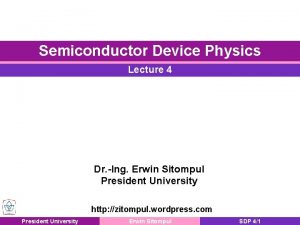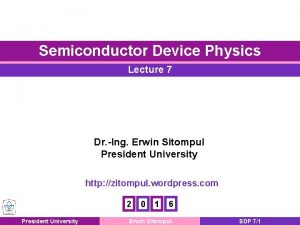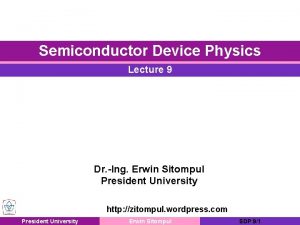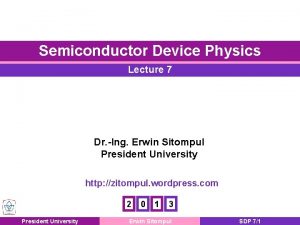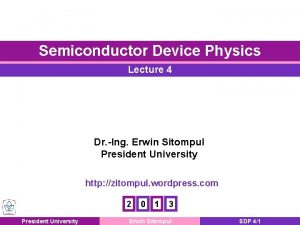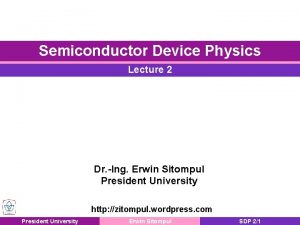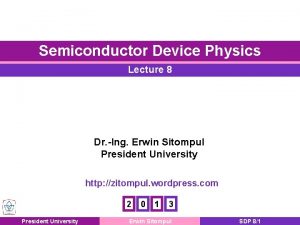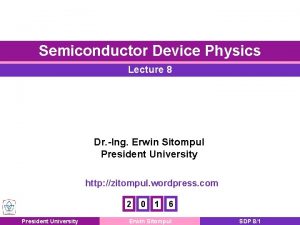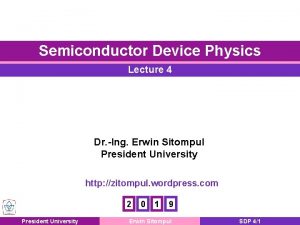Semiconductor Device Physics Lecture 10 Dr Ing Erwin






![Chapter 11 BJT Static Characteristics Avalanche Multiplication n Holes [0] are injected into the Chapter 11 BJT Static Characteristics Avalanche Multiplication n Holes [0] are injected into the](https://slidetodoc.com/presentation_image_h/37bdd47ee184fa77ea589685821a5f00/image-7.jpg)



















- Slides: 26

Semiconductor Device Physics Lecture 10 Dr. -Ing. Erwin Sitompul President University http: //zitompul. wordpress. com 2 President University 0 1 8 Erwin Sitompul SDP 10/1

Semiconductor Device Physics Chapter 11 BJT Static Characteristics President University Erwin Sitompul SDP 10/2

Chapter 11 BJT Static Characteristics Deviations from the Ideal n Common base Deviations, due to model limitations n Common emitter President University Erwin Sitompul SDP 10/3

Chapter 11 BJT Static Characteristics Base-Width Modulation n Common-Emitter Configuration Active Mode Operation n Recalling two formulas, W IE P+ + N P IC VEB Dp. B(x) (VCB = 0) 0 President University W Increasing reverse bias –VCB x Erwin Sitompul If reverse bias –VCB increases → W decreases → bdc increases → IC increases SDP 10/4

Chapter 11 BJT Static Characteristics Punch-Through n Punch-Through: E-B and C-B depletion regions in the base touch each other, so that W = 0. n As –VCB increases beyond the punch-through point, the E-B potential hill decreases and therefore increases the carrier injections and IC. WB = xn. EB + xn. CB President University Erwin Sitompul SDP 10/5

Chapter 11 BJT Static Characteristics Breakdown Mechanisms n In the common-emitter configuration, for high output voltage VCE, the output current IC will increase rapidly due to the two mechanisms: punch-through and avalanche. Punch-through Avalanche Increasing reverse bias of C-B junction President University Erwin Sitompul SDP 10/6
![Chapter 11 BJT Static Characteristics Avalanche Multiplication n Holes 0 are injected into the Chapter 11 BJT Static Characteristics Avalanche Multiplication n Holes [0] are injected into the](https://slidetodoc.com/presentation_image_h/37bdd47ee184fa77ea589685821a5f00/image-7.jpg)
Chapter 11 BJT Static Characteristics Avalanche Multiplication n Holes [0] are injected into the base [1], then collected by the C-B junction. n Some holes in the C-B depletion region have enough energy do impact ionization [2]. n The generated electrons are swept into the base [3], then injected into the emitter [4]. n Each injected electron results in the injection of IEp/IEn holes from the emitter into the base [5]. n For each pair created in the C-B depletion region by impact ionization, (IEp/IEn) + 1 > bdc additional holes flow into the collector. n This means that carrier multiplication in C-B depletion region is internally amplified. President University Erwin Sitompul pnp BJT M : multiplication factor SDP 10/7

Chapter 11 BJT Static Characteristics Geometrical Effects n Emitter area is not equal to collector area. n Current does not flow in one direction only. n Series resistance. n Voltage drop occurs not only across the junction. n Current crowding. n Due to lateral flow, current is larger around emitter periphery than the collector periphery. President University Erwin Sitompul SDP 10/8

Chapter 11 BJT Static Characteristics Graded Base n Dopants are injected through diffusion. n More or less falling exponential distribution with distance into beneath of the semiconductor. n The doping within the base is not constant as assumed in ideal analysis. n A function of position, having maximum at E-B junction and minimum at C-B junction. n Creating a built-in electric field. n The electric field enhances the transport of minority carrier across the quasineutral width of the base. n Increase of IE and IC. President University Erwin Sitompul xdiff : exponential decay constant SDP 10/9

Chapter 11 BJT Static Characteristics Figures of Merit Due to recombination in emitter depletion region Gummel Plot President University Due to high level injection in base, base series resistance, and current crowding Erwin Sitompul SDP 10/10

Chapter 11 BJT Static Characteristics Polysilicon Emitter BJT n bdc is larger for a poly-Si emitter BJT as compared with an allcrystalline emitter BJT. n This is due to reduced dp. E(x)/dx at the edge of the emitter depletion region. Lower mp § Continuity of hole current in emitter Shallower slope less JP higher g, b President University Erwin Sitompul SDP 10/11

Chapter 11 BJT Static Characteristics Summary on BJT Performance n High gain (bdc >> 1) n One-sided emitter junction, so that emitter efficiency g 1 Emitter doped much more heavily than base (NE >> NB). n Narrow base, so base transport factor a. T 1. Quasi-neutral base width << minority-carrier diffusion length (W << LB). n IC determined only by IB (IC function of VCE or VCB) n One-sided collector junction, so that quasineutral base width W does not change drastically with changes in VCE or VCB. Base doped more heavily than collector (NB > NC), W = WB – xn. EB – xn. CB for pnp BJT. President University Erwin Sitompul SDP 10/12

Semiconductor Device Physics Chapter 12 BJT Dynamic Response Modeling President University Erwin Sitompul SDP 10/13

Chapter 12 BJT Dynamic Response Modeling Qualitative Transient Response Saturation (ON) Load line Idealized switching circuit President University Cut-off (OFF) Erwin Sitompul SDP 10/14

Chapter 12 BJT Dynamic Response Modeling Qualitative Transient Response 1 cutoff 2 3 active saturation 4 2 5 1 saturation 3 4 5 active President University Erwin Sitompul SDP 10/15

Chapter 12 BJT Dynamic Response Modeling Charge Control Relationships n A pnp BJT biased in the active mode has excess minoritycarrier charge QB stored in the quasineutral base. n While Small n In steady state, President University Interpreted as average lifetime of an excess minority carrier Erwin Sitompul SDP 10/16

Chapter 12 BJT Dynamic Response Modeling Base Transit Time tt (Active mode) Interpreted as average time taken by minority carriers to diffuse across the quasineutral base President University Erwin Sitompul SDP 10/17

Chapter 12 BJT Dynamic Response Modeling Relationship between t. B and tt The lifetime of a minority carrier before it recombines in the base is much longer than the time it requires to cross the quasineutral base region President University Erwin Sitompul SDP 10/18

Chapter 12 BJT Dynamic Response Modeling Example n Given an npn BJT with W = 0. 1 μm and NB = 1017 cm-3. Find tt. From Figure 3. 5, mn = 801 cm 2/(V s) President University Erwin Sitompul SDP 10/19

Chapter 12 BJT Dynamic Response Modeling Turn-On Transient n During the turn-on transient: n The general solution is: n Initial condition: QB(0)=0, since transistor is in cutoff: tr : rise time, period of active mode President University Erwin Sitompul SDP 10/20

Chapter 12 BJT Dynamic Response Modeling Turn-On Transient IBBt. B > ICCtt bdc IBB > ICC bdc > ICC/IBB n In saturation mode: bdc > bdc(saturation) President University Erwin Sitompul SDP 10/21

Chapter 12 BJT Dynamic Response Modeling Turn-Off Transient n During the turn-off transient: n The general solution is: n Initial condition: QB(0)=IBBt. B: tsd : storage delay time President University Erwin Sitompul SDP 10/22

Chapter 12 BJT Dynamic Response Modeling Turn-Off Transient n The transient speed of a BJT depends on the amount of excess minority-carrier charge stored in the base and also the recombination lifetime t. B. n By reducing t. B, the carrier removal rate is increased, for example by adding recombination centers (Au atoms) in the base. n Tradeoff: bdc= t. B/tt will decrease. President University Erwin Sitompul SDP 10/23

Chapter 12 BJT Dynamic Response Modeling Practical Considerations n The foregoing analysis was highly simplified to avoid excessive amount of mathematics. n More realistic i. C transient response is shown below. n Added delay time td (due to charging of junction capacitance) and fall time tf. Collector current (mathematical model) Collector current (actual form) President University Erwin Sitompul SDP 10/24

Chapter 12 BJT Dynamic Response Modeling Homework 10 n 1. (E 11. 36 -B) The base of a silicon npn bipolar transistor is WB = 0. 8 μm wide. The doping concentrations are NB = 2× 1016 cm– 3 and NC = 1015 cm– 3. Determine the punch-through voltage. n 2. 3× 1016 cm– 3 (E 11. 37 -B) The base impurity doping level is NB = and the base width is WB = 0. 7 μm. If the required minimum punch-through voltage is determined to be Vpt = 70 V, calculate the highest level of collector doping. n 3. Next slide. n Deadline: Thursday, 6 December 2018. President University Erwin Sitompul SDP 10/25

Chapter 12 BJT Dynamic Response Modeling Homework 10 n 3. (EIE 130. AF 00 F) Consider a pnp silicon BJT of area A = 10– 6 cm 2 at 300 K. It operates in active region with VEB = 0. 6 V and VCB = – 1 V, so that WB = 0. 6 μm. Assume that the emitter and collector regions are much longer than the respective minority carrier diffusion length. Further data are given as follows: NE = 1019 cm– 3, NB = 1017 cm– 3, NC = 1015 cm– 3, DE = 2 cm 2/s, DB = 20 cm 2/s, DC = 12 cm 2/s, τE= 10– 7 s, τB= τC= 10– 6 s. a. What is the common-emitter d. c current gain of this transistor? b. What are the excess minority-carrier concentrations at the edges of the depletion regions (at A, B, C, and D in the diagram above). c. Calculate the collector current. President University Erwin Sitompul SDP 10/26
 Hardware output komputer
Hardware output komputer Semiconductor definition physics
Semiconductor definition physics Power semiconductor devices lecture notes
Power semiconductor devices lecture notes Semiconductor device fundamentals
Semiconductor device fundamentals Ee 130
Ee 130 Semiconductor device fundamentals
Semiconductor device fundamentals Transitor
Transitor Semiconductor device fabrication
Semiconductor device fabrication What does a semiconductor look like
What does a semiconductor look like Fcc wigner seitz cell
Fcc wigner seitz cell Semiconductor engineering physics
Semiconductor engineering physics Device physics
Device physics Semiconductors classification
Semiconductors classification 01:640:244 lecture notes - lecture 15: plat, idah, farad
01:640:244 lecture notes - lecture 15: plat, idah, farad Classical mechanics
Classical mechanics What is a harmonic wave in physics
What is a harmonic wave in physics Phy101 lecture 1
Phy101 lecture 1 Physics 101 lecture notes pdf
Physics 101 lecture notes pdf Waves 1 physics notes
Waves 1 physics notes Atmospheric physics lecture notes
Atmospheric physics lecture notes Art humanistic psychology
Art humanistic psychology Mg modelo de dalton
Mg modelo de dalton Erwin schrödinger model of atom
Erwin schrödinger model of atom Modelo atomico modelo actual
Modelo atomico modelo actual Schrodinger atomic theory
Schrodinger atomic theory Erwin moeyaert
Erwin moeyaert Erwin sitompul
Erwin sitompul

